�
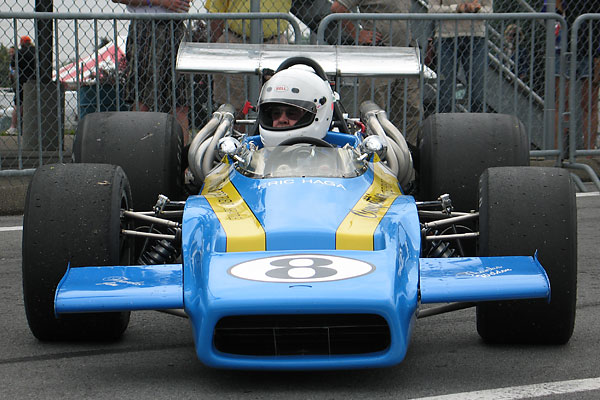
�
Eric Haga's Lola T190 Formula 5000 Racecar, Number 8
� � Owner: Eric Haga� City: Seattle Washington
� Model: Lola T190 (circa 1970)
� Engine: Chevrolet 302cid V8 engine.
� Restored by: owner.�
�
Lola's Answer to Rising Competition in F5000
��
In the early years of Formula A and Formula 5000 racing, Lola Cars Ltd. was the most �
prolific constructor. Lola's T140 and T142 models sold well and enjoyed a good reputation.�
Their only big problem was they didn't win their share of races. Between 1968 and�
1969, there were twenty-three North American Formula 5000 races and Lola cars captured�
just two wins. By the end of 1969, the spaceframe chassis of the T140 and T142 were �
looking old-fashioned compared to newer monocoque chassis from McLaren, Surtees, and �
Eagle. �
�
Lola's answer was the all-new T190. Knowing that the last race of the season is always�
remembered clearest when race teams order new cars, Lola delivered the T190 just in time. �
It would debut at the last race of 1969 in Sebring Florida on December 28, 1969. �
�
Despite arriving at the track late and missing a day of practice and tuning time for his �
brand new car, Mark Donohue managed to qualify third. The actual race was comprised of �
two 100 mile heats. Donohue dropped out of both heats due to the same problem: clogged �
under-sized fuel filters. He was in second place when he retired from the first heat, �
and in first place when he retired from the second. As Donohue later wrote: "We had �
showed everyone that we had the fastest car, but we just hadn't put enough time or care �
into the preparation."¹ Another of the teams that Lola seeded with fresh equipment �
won a spot on the podium: Jo Bonnier drove his new T190 to finish third. As 1969 ended, �
things were looking up for Lola. �
�
Probably the most interesting (and controversial) thing about the new T190 design was �
its very short wheelbase. At 92 inches, it was 7.5 inches shorter than the already �
notably short McLaren M10a. To achieve such a short wheelbase, the driver was positioned �
farther forward than in almost any other formula car. �
�
Despite Mark Donohue's enthusiasm for the short wheelbase, many of Lola's customers�
didn't seem to like it. In terms of victories, it was demonstrably more successful than its �
predecessors: Ron Grable won two of 1970's first ten North American Formula 5000 races, and �
the T190 also picked up three wins in the (20 race) UK series. However, customer concerns �
about the short wheelbase were heard back at the factory. Some teams had trouble getting�
the suspension settings dialed-in for optimal handling. Before the 1970 season ended, Lola �
introduced a new longer-wheelbase model called the T192. It was basically the same design �
as the T190, except with the front wheels moved forward to extend the wheelbase by about �
ten inches. Mark Donohue drove a new T192 to win two of the three final races of the 1970 �
North American Formula 5000 season. �
�
Lola produced seventeen T190 racecars, followed by twelve T192 racecars.�
�
�
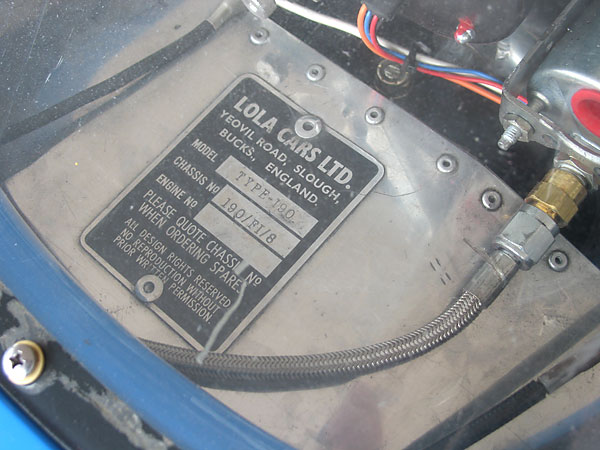
�
LOLA CARS LTD., YEOVIL ROAD, SLOUGH, BUCKS., ENGLAND.
�
Model: "TYPE-190", Chassis No.: "190/FI/8", Engine No.: (blank)
�
Please quote chassis number when ordering spares.
�
All design rights reserved. No reproduction without prior written permission.
�
Eric Haga's Lola T190: Chassis 190/FI/8
� �
Jim Matuska and Eric Haga had been campaigning cars together in regional races for�
several seasons. They started with a Porsche-powered Corvair for the 1967 season, �
and switched to a McLaren Mk3 for '68 and '69. Jim had the money to invest in top�
flight racecars, and Eric had the talent to drive them. With the McLaren, the two �
friends competed up and down the west coast, and entered in the Laguna Seca and �
Riverside Can-Am Series races. �
�
For 1970, they needed a newer car and they were initially undecided about what racing �
class they'd like to pursue. Ultimately, Jim Matuska decided that Formula 5000 was�
more appealing. He began making arrangements to set up a racing team with two cars, �
two drivers, and a sponsoring company. The team was organized as a division of Jim �
Matuska's and Weldon Andrews' successful aircraft components company. Larry Webb �
was hired on to be the team's crew chief. Larry brought in John Garrison to be the �
team's engine builder. Eric Haga would drive one new Lola T190, purchased by Jim �
Matuska. A second T190 was purchased and driven a friend and fellow Seattle area �
racer named Spence Stoddard. �
�
In November 1969, the new Competition Development division of Sealth Aero Marine wrote �
a purchase order to Charlie Hayes Racing Equipment, the West Coast sub-distributor (under Carl Haas) �
of Lola racecars, for two Lola T190 Formula 5000 racecars. The price was $15,500/each,�
including spares. �
�
 | |
| SPECIFICATIONS SHEET | �
|
| LOLA T-190 FORMULA A | �
|
| CHASSIS: | �Aluminum alloy monocoque - bonded and riveted construction. � Torsional rigidity of 300,000 foot pounds per degree per foot. [sic]² � Weight: 70 pounds | �
| DIMENSIONS: | �Wheelbase 92"³ � Track 58" � Length 150" � Width 77" � Height (top of windscreen) 26" � Height (to of roll bar) 35" � Weight (including oil and water) 1,310 lbs. | �
| BODY: | �Fiberglass reinforced polyester resin. Nose cone and cockpit � surround. Alloy rear hub mounted wing and front canard fins (option). | �
| SUSPENSION: (FRONT) | �Independent. Double tubular wishbones and telescopic double- � acting shock absorbers with co-axial coil suspension springs. � Adjustable ride height. | �
| � | HUB CARRIER: Lola cast magnesium with "live" spindle. � Bearings of 160,000 pounds/square inch � nickel chrome molybdenum steel. | �
| � | WISHBONE PIVOTS: Rod end ball joints to inner enda and ball � joints in housing to outer end. All joints � high-quality Fabroid type. | �
| SUSPENSION: (REAR) | �Independent. Lower reversed wishbone and link. Upper link � and radius rod with telescopic double acting shock absorbers. � Co-axial coil suspension springs and adjustable ride height. | �
| � | HUB CARRIER: Lola cast magnesium with "live" spindle. Hub � bearings of 160,000 pounds/square inch nickel chrome � molybdenum steel, mounted in hub carrier splined for driveshaft yoke. � |
| � | WISHBONE & RADIUS ROD PIVOTS: as in front suspension. | �
| STEERING: | �Rack and pinion with 11" diameter leather covered steering � wheel. Column adjustable for length and angle. | �
| TRANSMISSION: | �Hewland DG-300 five speed and reverse. | �
| CLUTCH: | �Borg & Beck multi-plate (option) | �
| DRIVE SHAFTS: | �Lola design with Metalastic rubber "Doughnut". | �
| BRAKES: | �Girling 12" vented discs | �
| WHEELS: | �Front: 10.5" x 15"; Rear: 17" x 15" | �
| FUEL CELLS: | �30-gallon capacity with surge tank for pump pick-up. | �
| ENGINE: | �Chevrolet 302" with Lola dry sump and water pump conversion (option). � Small diameter Lola flywheel. Weber 48 IDA carburetors. Lucas � transistor or Bosch magneto ignition. Lucas fuel injection optional. | �
| COOLING SYSTEM: | �Brass fin and tube radiator. Water pipes separate and insulated. | �
| ELECTRICS: | �AC Delco or Lucas with Varley battery. | �
| INSTRUMENTS: | �Smiths tachometer, pressure, and temperature gauges. | �
| HOSES & FITTINGS: | �Aeroquip and A.N. | �
�
The two new cars would arrive in Seattle early in February 1970. The number eight car, �
190/FI/8 (as shown in this article) could have arrived earlier, except that Lola borrowed �
it for their display at The British Racing and Sports Car Club's "Racing Car Show"�
at Earl's Court in London. The number nine car was being constructed during the show, �
and it arrived in Seattle about a week after 190/FI/8. After the cars were received, �
Larry Webb took them completely apart and send all the suspension parts out to an FAA �
certified inspection facility to be checked for cracks and casting flaws. Then, he �
reassembled the car, replacing all the original hardware with MS NAS and AN (aircraft) �
grade fasteners. �
�
�
Enjoying this article? www.BritishRaceCar.com is partially funded through generous support from readers like you!
�
To contribute to our operating budget, please click here and follow the instructions.
�
(Suggested contribution is twenty bucks per year. Feel free to give more!)�
�
The two cars were supplied without engines, so the team purchased two Chevrolet racing �
engines from TRACO to be used at the first race (Riverside) which was coming up �
quickly. After that, John Garrison built the remainder of the team's engines. He used �
Chevrolet Z28 4-bolt main bearing blocks, bored 0.040" over. A standard stroke crankshaft�
was used, along with Carrillo rods and hot Isky camshafts. The engines produced about�
500hp on the shop's dyno. They normally built new engines for every race weekend. Based �
on the team's dyno testing, Weber downdraught carburetors produced almost 15hp less than �
the "Jackson Constant Flow Fuel Injection" system, so after the third race (Seattle) the �
team used fuel injection for the remainder of the season.�
�
| Eric Haga's results with 190/FI/8 in the 1970 L&M Continental (Formula 5000) Championship Series | |||||
| Venue | Date | Qualified | Finished | Notes | |
| 1 | Riverside | April 19 | 9 | 7 | |
| 2 | Edmonton | May 24 | 8 | DNF | Crash |
| 3 | Seattle | June 7 | 15 | 7 | |
| 4 | Laguna Seca | June 14 | 19 | 11 | |
| 5 | Sears Point | June 28 | 9 | DNF | Crash |
| 6 | Dallas | July 5 | 17 | 7 | |
| 7 | Road America | July 18 | 18 | DNF | Engine (valve) |
| 8 | Mt Tremblant | April 19 | 10 | 6 | |
| 9 | Donnybrooke | May 24 | 20 | 9 | |
| 10 | Lime Rock | June 7 | 13 | 9 | |
| 11 | Mosport | June 14 | 22 | DNS | Engine (valve) |
| 12 | Mid-Ohio | June 28 | 15 | DNF | Engine (fuel injection) |
| 13 | Sebring | July 5 | ? | DNS | Engine (magneto), on pace lap |
�
After the 1970 season, the number eight car was traded-in on a new T192, which Eric Haga �
drove throughout 1971. The T190 was re-bodied and driven by Bobby Unser in 1971's Questor �
Grand Prix. �
�
Eric Haga bought 190/FI/8 in 2008, and began restoring it for vintage racing. His ambition�
is that the restoration be as accurate as feasible. To that end, Eric in close consultation with�
Glyn Jones and Bob Marston. Glyn is the Heritage Coordinator at Lola Cars in England. Bob�
is retired now, but he was the principal designer of the T190. Bob Marston came to Lola �
after previously working at Cooper and Surtees. �
�
Except for tasks that require very specialized equipment or unusual skills, Eric is �
doing most of the restoration work himself, and it's a continuous project. His current focus�
is on fine tuning the suspension set-up, based on recommendations from Bob Marston as the �
original designer. Once the latest changes are tested and finalized, Eric plans to install �
a high-mounted rear wing, identical to what the car originally raced with. After that, the�
next planned change is to retrofit a Jackson constant flow fuel injection system. �
�
�
 �
�
�
�
Features and Specifications (as of September 2009)
�| Engine: | �Chevrolet 302cid V8 engine, rebuilt by Larry Webb.�
Approximately 11.5:1 static compression ratio.�
Weber 48IDF downdraught carburetors.�
K&N air filters. �
Professional Products "PowerForce+Plus" harmonic balancer.�
Vertex magneto. �
Taylor Spiro Pro 8mm silicone insulated spark plug wires.�
ETC Incorporated high range 12V magneto rev limiter.�
Armstrong Race Engineering dry sump oil pan.�
Weaver Brothers oil pump.�
Earl's Performance Products engine oil cooler.�
Wix 51515R racing oil filter, remote mounted. | �
| Cooling: | �Serck brass dual-pass radiator (L2289-13). | �
| Exhaust: | �custom fabricated four-into-one headers, ceramic-coated. | �
| Transaxle: | �Hewland DG300 (-206) 5-speed with 9.31:1 ring and pinion.�
5.25" Metalastic donut-coupled halfshafts. | �
| Front Susp.: | �KONI 8212 coilover shock absorbers with Hypercoil springs. Adjustable anti-sway bar. | �
| Rear Susp.: | �KONI 8212 coilover shock absorbers with Hypercoil springs. Adjustable anti-sway bar. | �
| Brakes: | �(master) dual Girling master cylinders with remote reservoirs and bias bar. � (front) Girling calipers and 12" vented rotors. � (rear) Girling calipers and 12" vented rotors. | �
| Wheels/Tires: | �original Lola cast magnesium wheels (15"x10.5" front, 15"x17" rear). � Goodyear Eagle Sportscar Special (23.0x10.5x15 front, 27.0x14.0x15 rear). | �
| Electrical: | �Varley Redtop 30 battery. | �
| Instruments: | �(left to right) �
Stewart Warner voltmeter (10-16V),�
Stewart Warner oil temperature gauge (140-320V),�
Stewart Warner oil pressure gauge (5-100psi),�
Stack electronic tachometer (0-8000rpm),�
AutoMeter coolant temperature gauge (120-240F). | �
| Fuel System: | �Holley "red" fuel pump. Holley fuel pressure regulator. �
Professional Products "Powerflow" fuel filter.�
Mooneyes fuel pressure gauge (0-15psi, mounted at carburetors). | �
| Safety Eqmt: | �Willans six-point cam-lock safety harness. Quick release steering wheel hub.�
FireBottle 2.5lb Halon centralized fire suppression system. | �
| Racing Class: | �Formula 5000 | �
Engine Installation
��
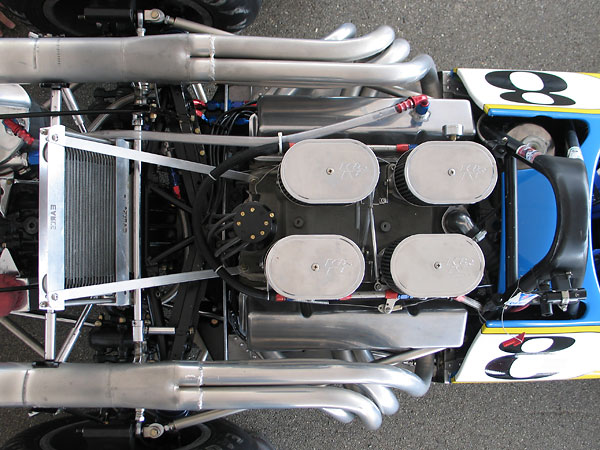
�
The Chevrolet 302cid V8 engine has been rebuilt for vintage racing by Competition Development's
�
original Crew Chief, Larry Webb. Its build complies fully with the original 1970 rules.
�
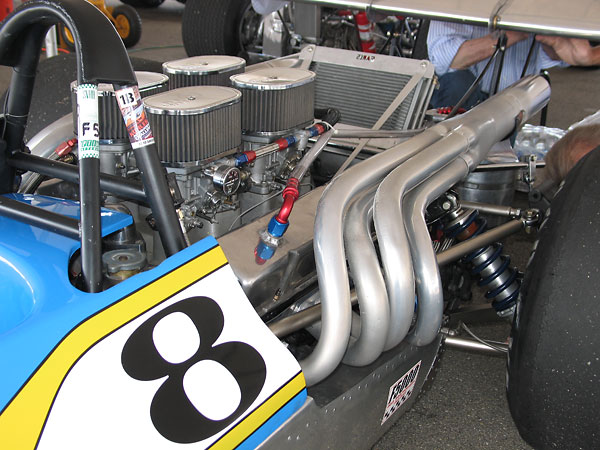
�
Weber 48IDF downdraught carburetors with K&N air filters. In 1970, the Competition Development
�
team switched from Weber carburetors to a Jackson constant flow fuel injection system after just
�
three races. Eric Haga has now procured a Jackson system, and will install it during the 2010 season.
�
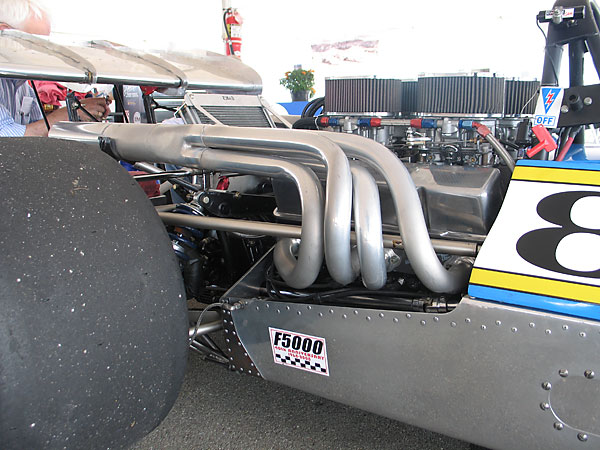
�
The Competition Development team had their own Heenan & Froud engine dynomometer. Among other
�
things, they used it for developing custom exhaust headers to suit their engines. The headers shown
�
here were custom fabricated to match the original 1970 Competition Development design.
�
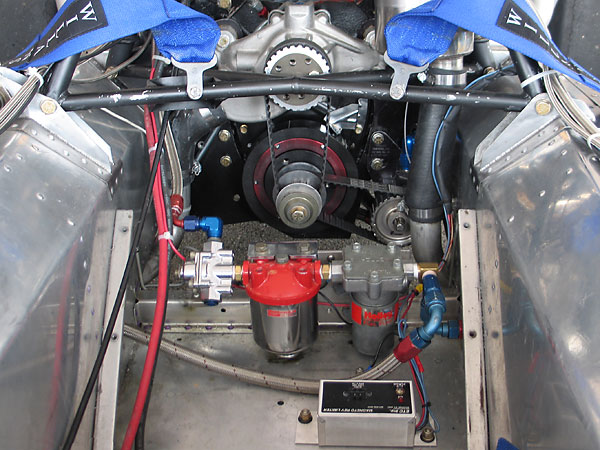
�
Professional Products "PowerForce+Plus" harmonic balancer.
�
Holley fuel pressure regulator. Professional Products "Powerflow" fuel filter. Holley "red" fuel pump.
�
ETC Incorporated 12V magneto rev limiter.
�
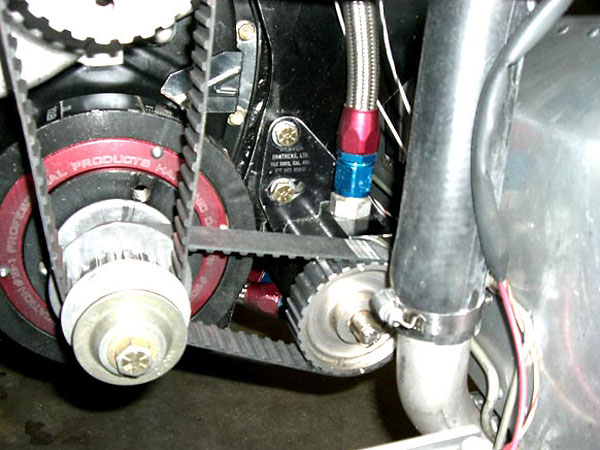
�
This Weaver Brothers oil pump is just like the one used throughout 1970. Lola supplied their own dry
�
sump oil pan, but the car is currently using a (similar looking) Armstrong Race Engineering pan instead.
�
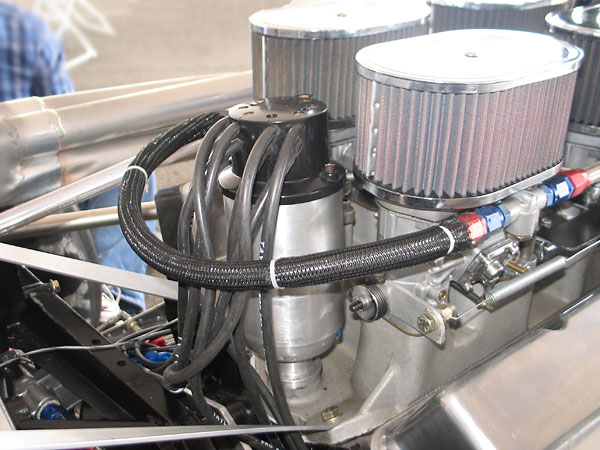
�
Vertex magneto. Taylor Spiro Pro 8mm silicone insulated spark plug wires.
�
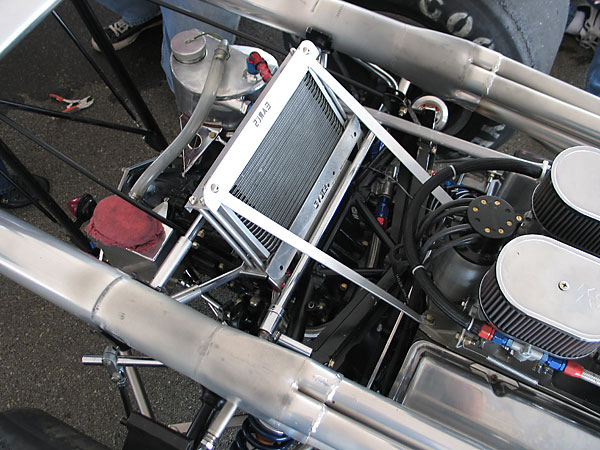
�
Earl's Performance Products engine oil cooler. The original Lola T190 design had the oil cooler co-located
�
with the radiator in the nose-pod. That worked okay... until the team got to Dallas. For the rest of the
�
1970 season, the team used a rear mounted oil cooler and found it reduced oil temps by 10-15° F.
�
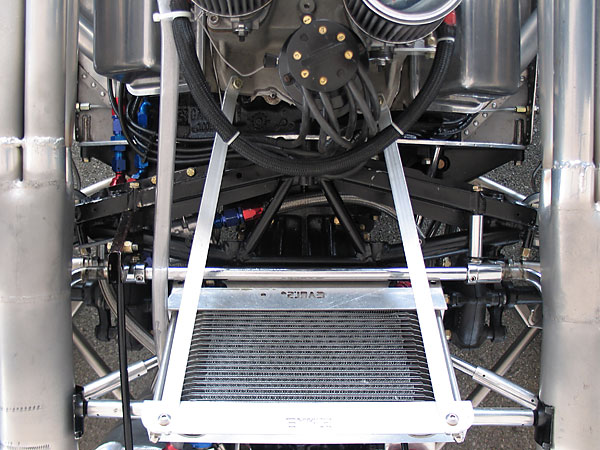
�
Rear bulkhead.
�
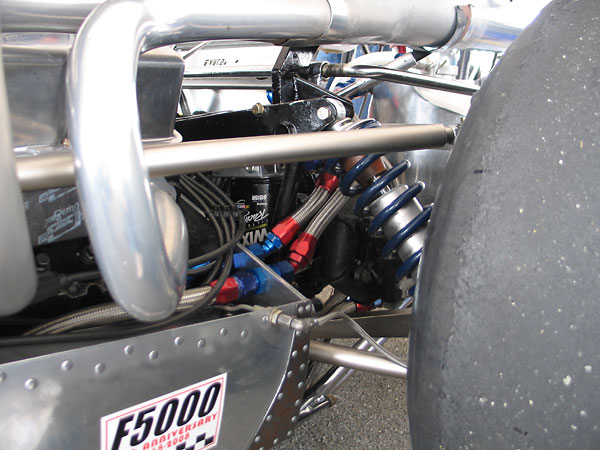
�
Wix 51515R racing oil filter, remote mounted.
�
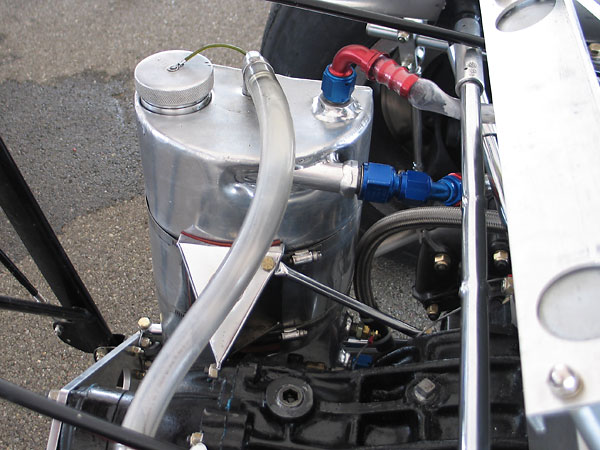
�
Original aluminum oil reservoir tank, as supplied by Lola Cars.
�
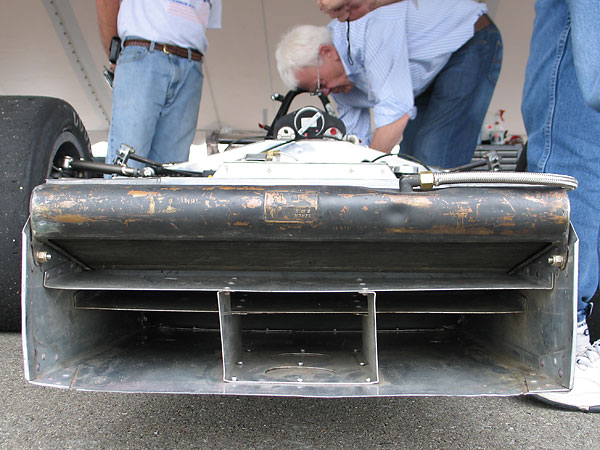
�
Serck all-brass dual-pass nose-mounted radiator. (It's marked part number L2289-13.)
�
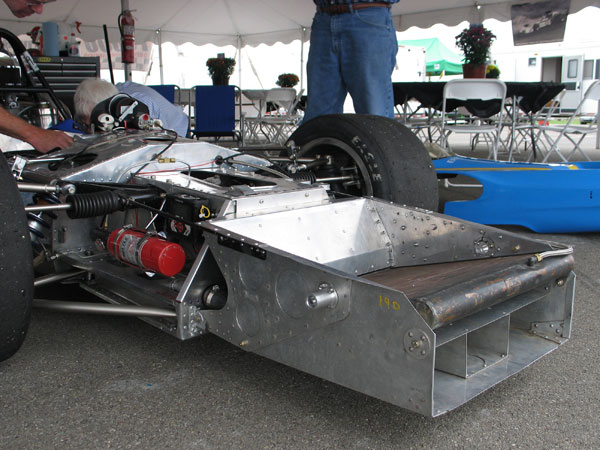
�
Notice that dividers (both horizontal and vertical) distribute airflow over the whole radiator core.
�
�
Front Suspension / Steering / Etc.
��
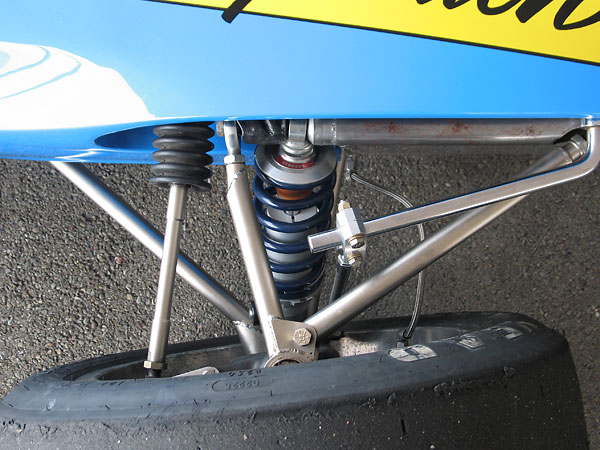
�
Left front suspension.
�

�
Lola supplied the T190 with Armstrong shock absorbers, but Competition Development took them off and
�
replaced them with lightweight, aluminum KONI 8212 double adjustable shocks (exactly like the ones shown
�
here) before the car was ever raced. They used KONI shock absorbers throughout the 1970 season.
�
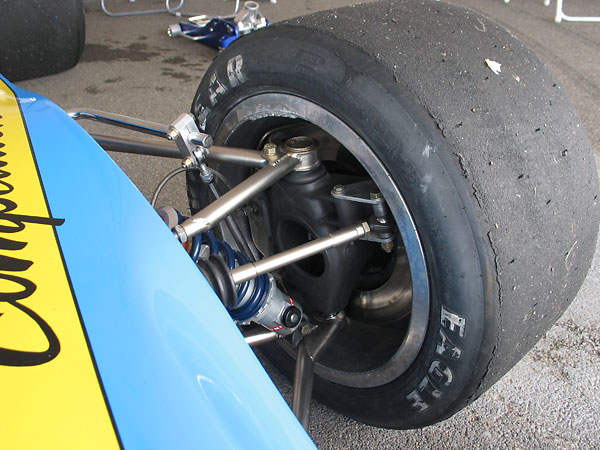
�
Steering link connections to Lola's magnesium uprights provide a wide range of bump steer adjustment.
�
That's necessary because there's no possibility of raising or lowering the steering rack.
�
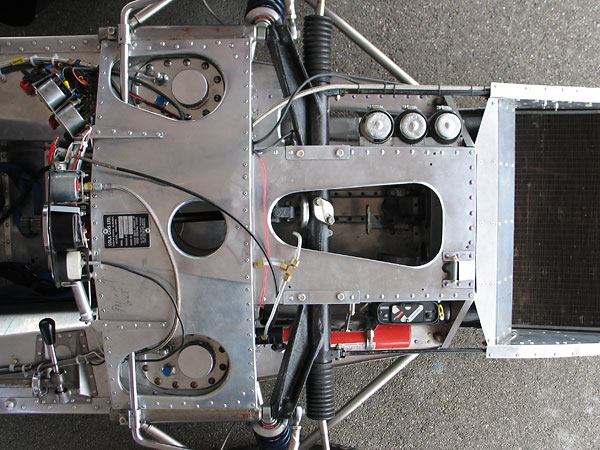
�
Besides showing the monocoque construction, this photo also illustrates just how
�
far forward the driver's feet are compared to the front wheels.
�
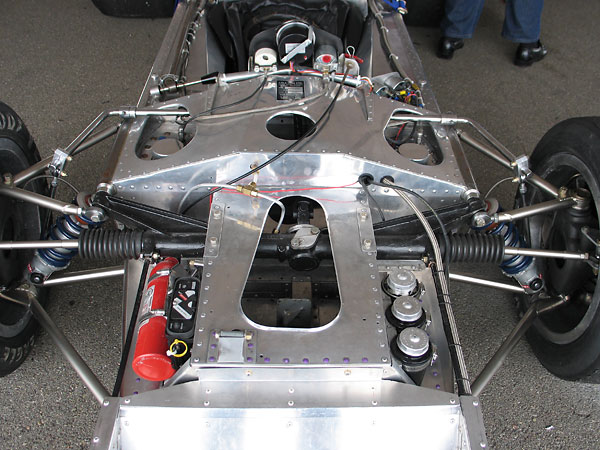
�
Lola designed an elaborate casting for the steering rack, and inexplicably placed the pinion off-center.
�
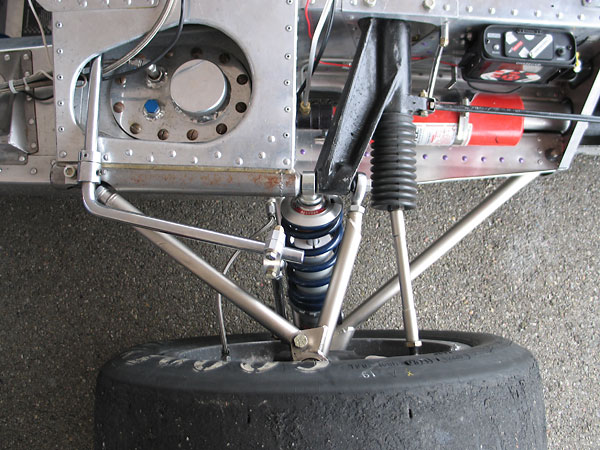
�
Refueling the Lola T190 requires removing the fiberglass bodywork. If the rubber fuel cell bladders
�
need service, they're also accessed through these holes in the monocoque tub.
�
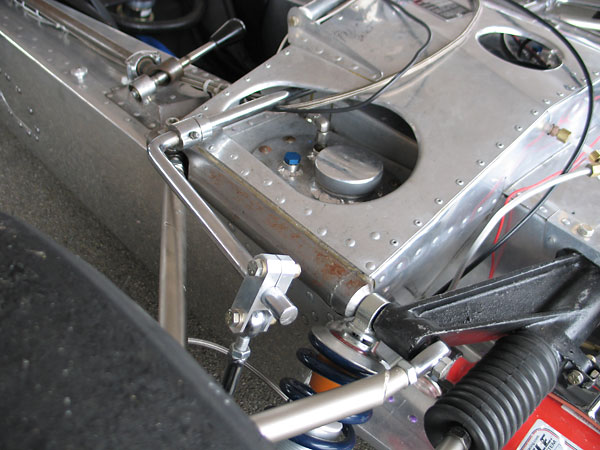
�
Adjustable front anti-sway bar. The team tried lots of sway bar changes and adjustments over the season,
�
in an attempt to reduce understeer. They finally had things about perfect by Mid-Ohio. Mark Donohue was
�
there, and he crashed the Penske T192 during practice. Eric invited him to take out chassis 190/FI/8 for
�
a few test laps. Mark Donohue's only suggestion was to try a little toe-out. They tried it, and it worked!
�
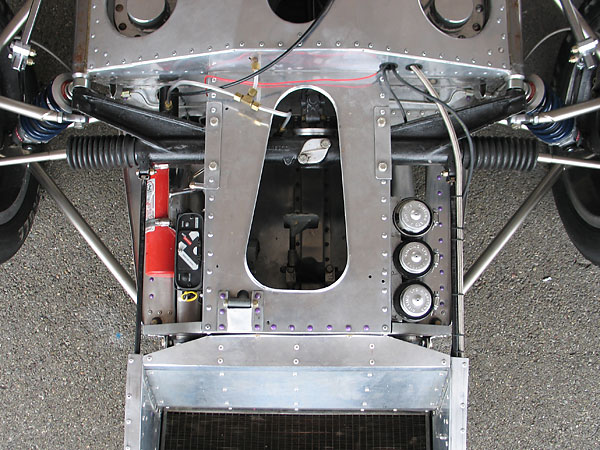
�
Two thin radius rods extend forward from bosses on the steering rack to support the cooling system.
�
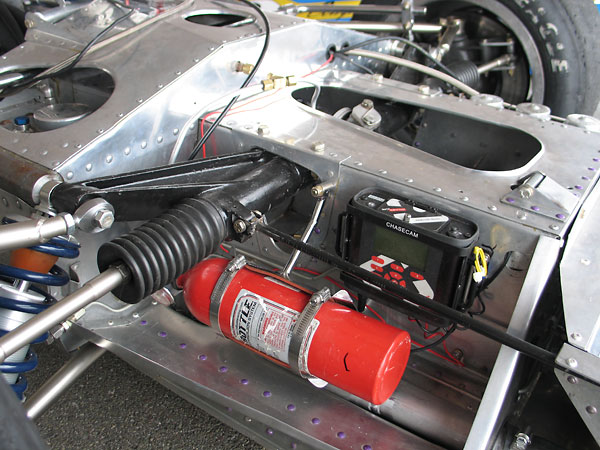
�
FireBottle 2.5lb Halon centralized fire suppression system.
�
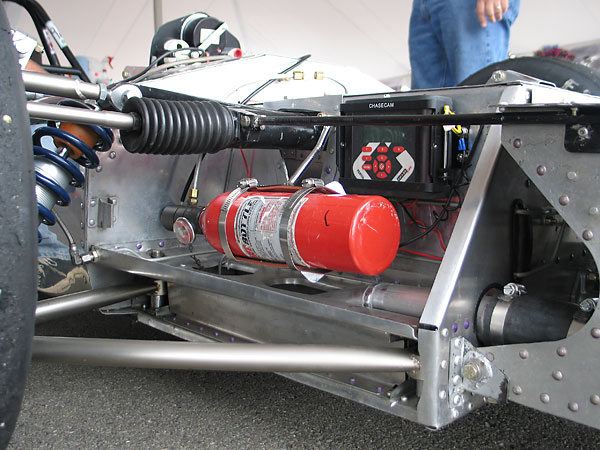
�
The ChaseCam PDR-100 digital video system stores race footage on a CF memory card in MPEG format.
�
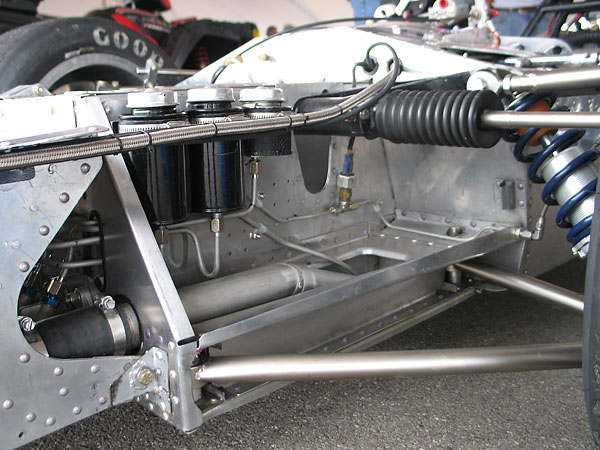
�
Inboard connections of the lower control arms can be adjusted for height, which means it's feasible to
�
adjust the amount of anti-dive characteristic in the front suspension to some extent. However, fine
�
adjustment of caster and camber must be completed at the upper control arms.
�

�
Dual Girling master cylinders with bias bar for the brake system.
�
Foreground: an AMB TranX 260DP transponder.
�

�
Girling steel reservoirs for the brake and clutch hydraulic systems.
�
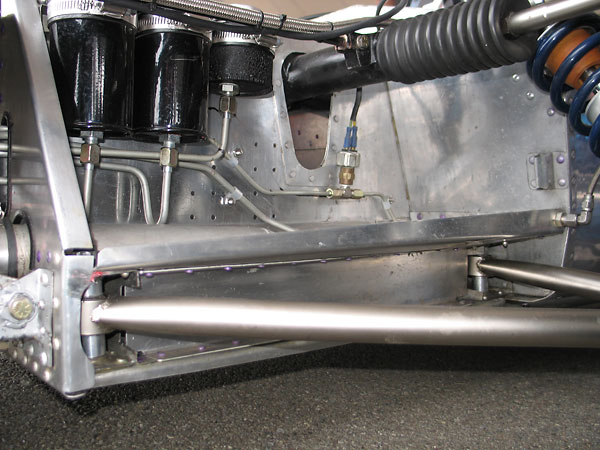
�
A hydraulic pressure switch turns on the brake light.
�
�
Enjoying this article? www.BritishRaceCar.com is partially funded through generous support from readers like you!
�
To contribute to our operating budget, please click here and follow the instructions.
�
(Suggested contribution is twenty bucks per year. Feel free to give more!)�
Rear Suspension / Transaxle / Etc.
��
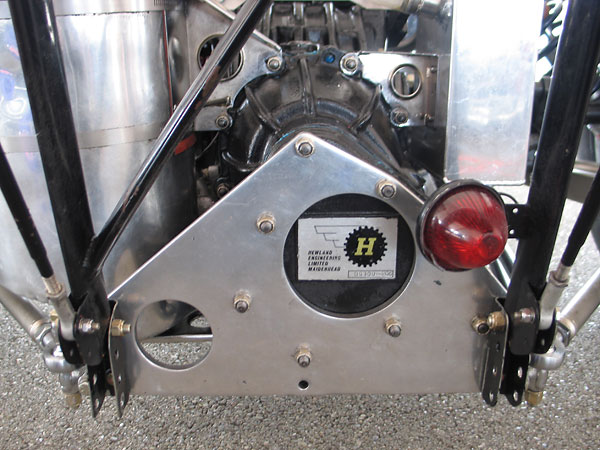
�
"Hewland Engineering Limited, Maidenhead DG300-206"
�
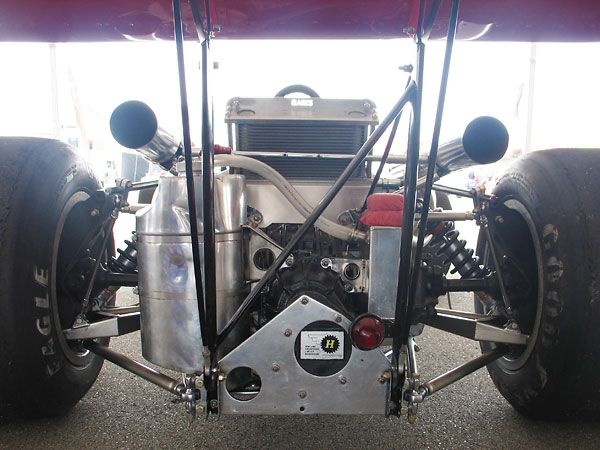
�
The Hewland DG300 5-speed was a lot lighter than the LG600 six speed that was popular in F5000 one
�
year before. It had five forward speeds plus reverse, and all five gear ratios were easily replaceable, so
�
the Competition Development team selected ratios to suit the respective tracks they raced on.
�
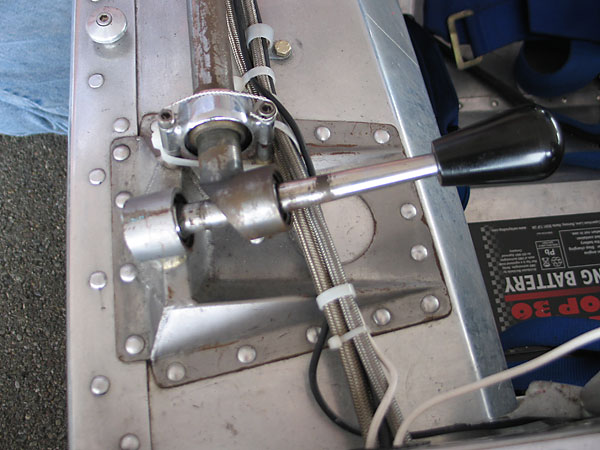
�
Here's a close-up of the gear selector.
�
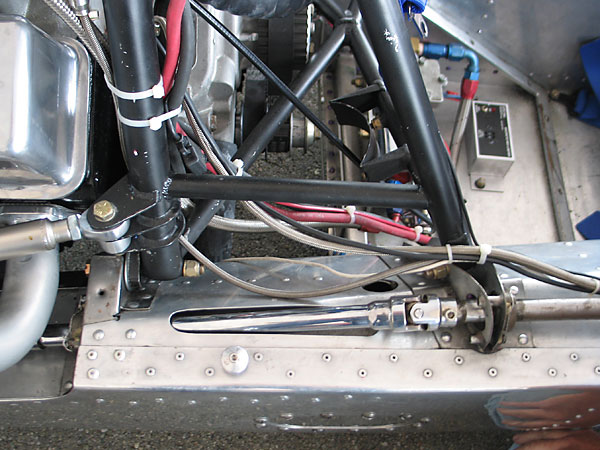
�
The gear selector linkage is routed through a slot in the aluminum monocoque tub. Also shown:
�
the rear suspension's trailing links connect to tabs on the rollhoop / subframe.
�
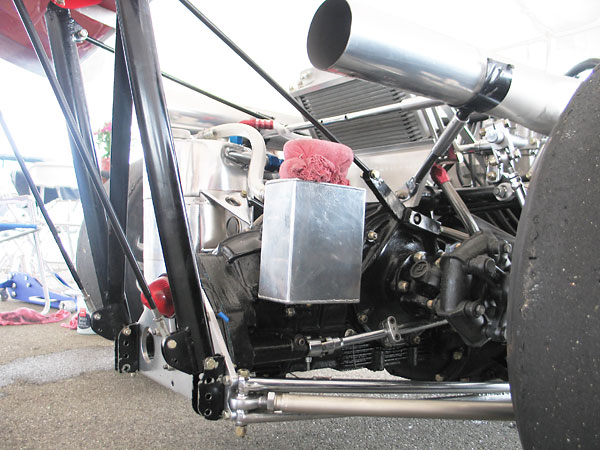
�
Whereas most formula cars have twin trailing links from the chassis back toward the rear wheel uprights,
�
the Lola T190 instead has its lower links behind the wheels. These links are loaded in compression under
�
braking and in tension under forward acceleration. Evidently the latter situation was given priority.
�
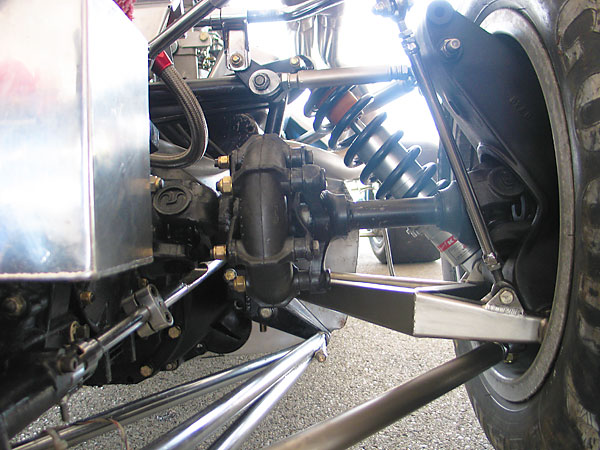
�
The lower radius rods aren't mounted at the same height as the lower control arms.
�
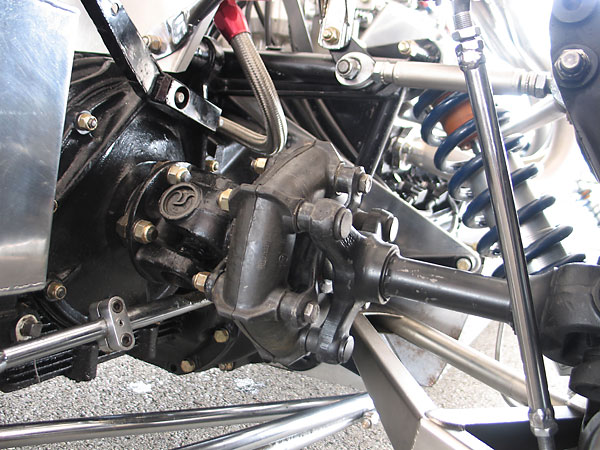
�
Metalastic rubber donuts absorb length variation at the halfshaft which occurs as the suspension works.
�
For this purpose, their advantage is they don't add friction or bind unpredictably. Smaller versions had
�
worked fine on thousands of low-power British cars for a decade, but Lola made a bold choice when they
�
put Metalastic donuts on 500+ hp racecars with sticky racing slicks. This size of Metalastic donuts
�
must work above rated specs, so their recommended service life is only a couple race weekends.
�
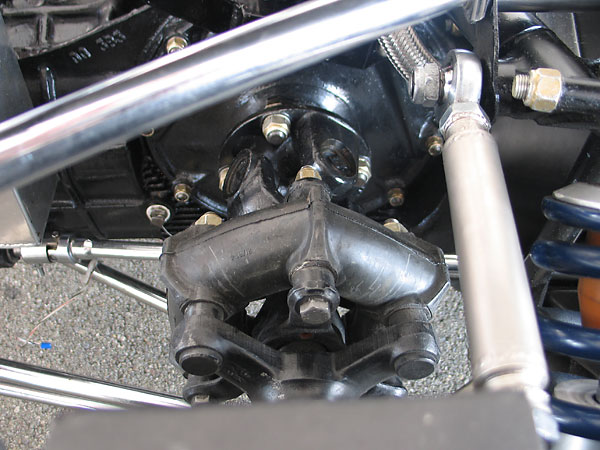
�
In 1970, Metalastic donuts were a relatively inexpensive and low-maintenance alternative to ball-splined
�
couplings or CV joints. Not anymore! According to Craig Taylor of Taylor Race Engineering, replacement
�
Metalastic donuts are still made in England by Dunlop, but the 5.25" size currently cost about $675/each.
�
The necessity for frequent replacement makes them a surprisingly costly maintenance item. For vintage
�
racing, Craig says it would be economical and safer to install modern halfshafts. Custom halfshafts with
�
108mm Lobro CV joints would require a one-time investment of about $3000. The conversion would be
�
easily and completely reversible.
�

�
KONI 8212 shock absorbers are adjustable in both compression (at the bottom) and rebound (at the top).
�
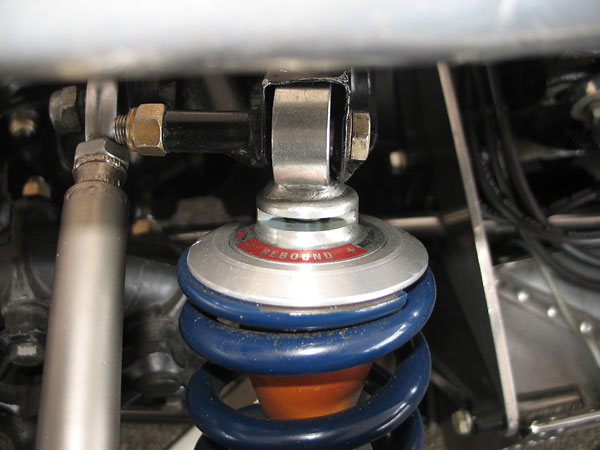
�
The rebound dampening adjustment dial is recessed into this slot. A thin tool (e.g. 3/32" Allen wrench)
�
is inserted into the slot and swept from side to side to turn the dial and make the desired adjustment.
�
�
Interior
��
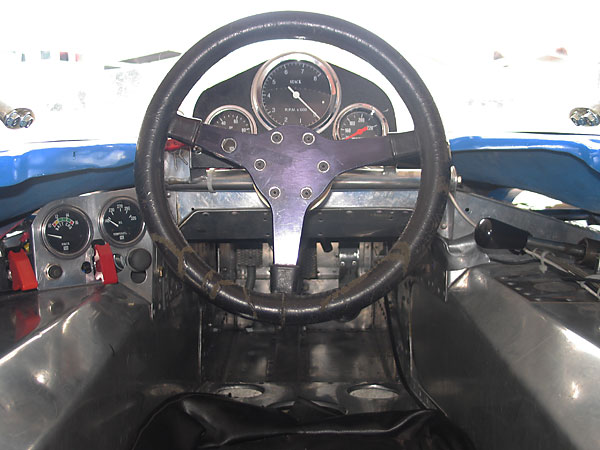
�
This is believed to be the original steering wheel that was supplied by Lola. In restoring the car to its
�
original appearance, an exact replacement wasn't found. After we took this photo, a similarly designed
�
Moto-Lita steering wheel was installed. As raced in 1970, the car didn't have a quick release steering
�
wheel hub, but a new spline-type hub has been installed for safety reasons.
�

�
Lola supplied the T190 with Smiths instruments, but they were replaced before it was ever raced.
�
The Competition Team preferred Stewart Warner gauges and Jones/Motorola mechanical tachometers.
�
Shown here: Stewart Warner voltmeter (10-16V) and oil temperature gauge (140-320V).
�
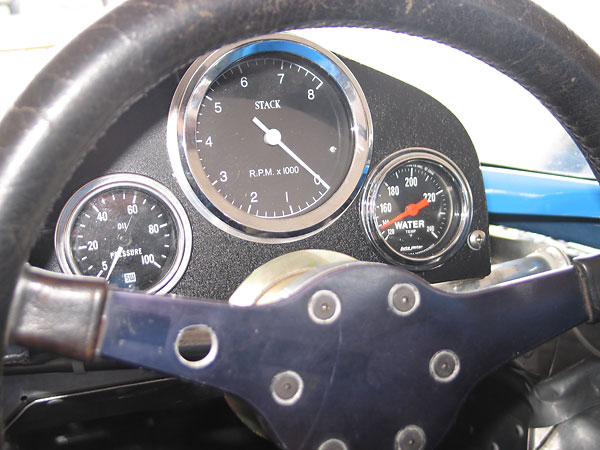
�
When we photographed the car it had a Stack electronic tachometer, which has recently been replaced
�
with an authentic Jones cable-driven tach. The Stewart Warner oil pressure gauge (5-100psi) shown here
�
remains in the car, but the AutoMeter water temperature gauge has recently been replaced too.
�

�
Gear selector, as viewed from the driver's seat.
�
�
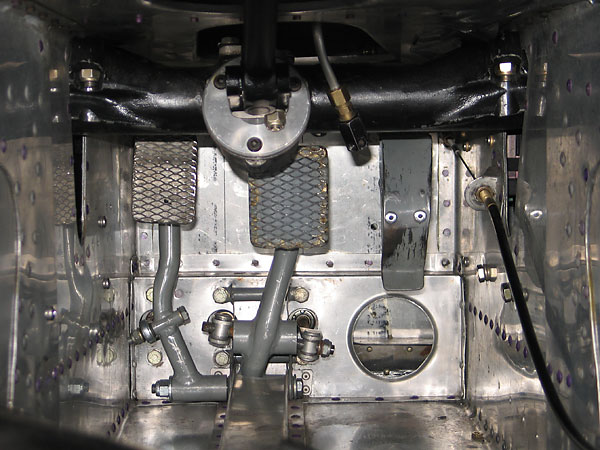
�
Rather elaborately designed pedals. No dead-pedal was provided for the left foot.
�
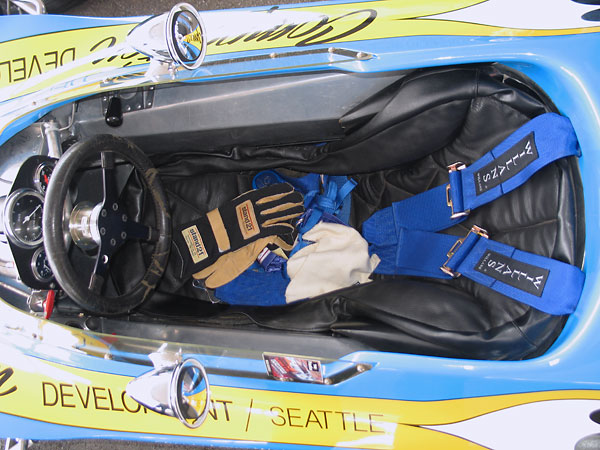
�
Willans six-point cam-lock safety harness.
�
�
Exterior
��
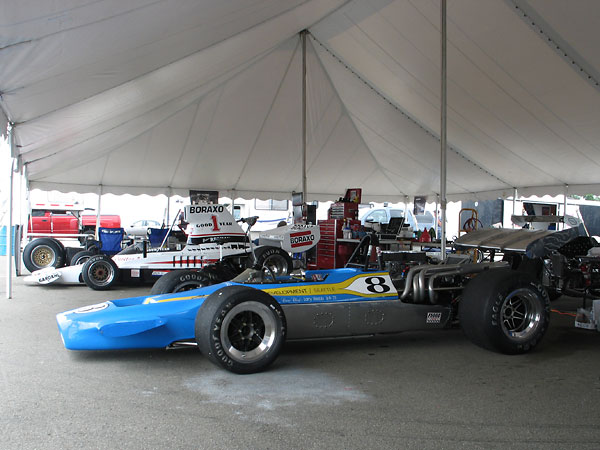
�
Two generations of Formula 5000 cars: the car in the background is the Lola T332 that Brian Redman
�
drove to Formula 5000 Championship Victory in 1976. Eric's T190 looks resplendent and remarkably true
�
to how it looked while contesting every single event of the 1970 Formula 5000 season.
�
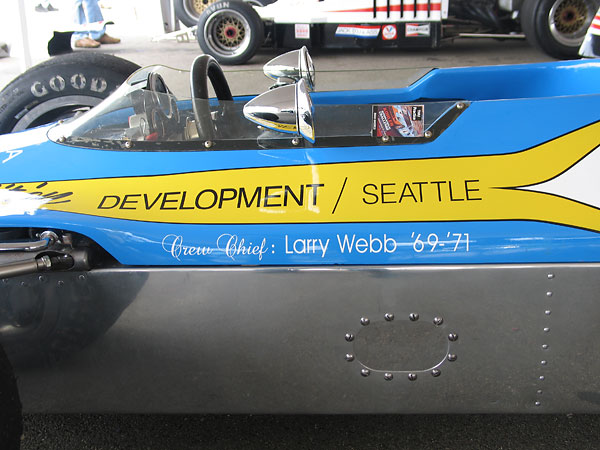
�
"Crew Chief: Larry Webb '69-'71"
�
Roy Dunn of Dunn Auto Graphics in Des Moines, Washington recreated the car's original graphics,
�
with modest and tasteful changes to suit the car's new career in vintage racing.
�
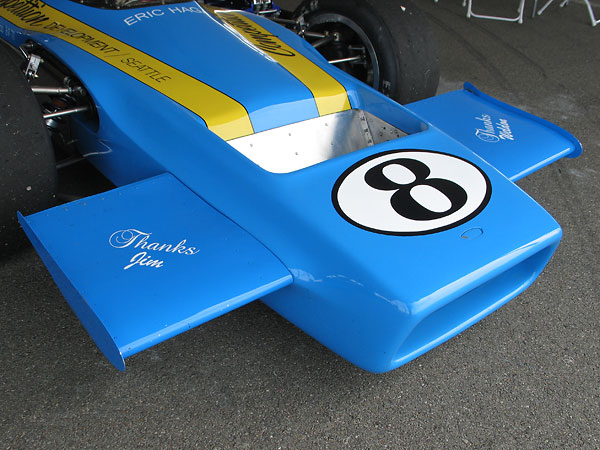
�
"Thanks Jim" - "Thanks Weldon"
�
Note: the front wings were used with end-plates early in the 1970 season, but not at the end.
�
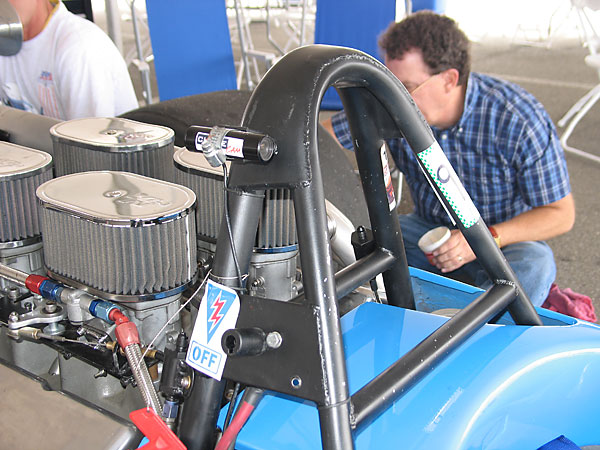
�
At St.Jovite, Eric's teammate Spence Stoddard rolled his own T190 over. A new roll hoop was required to
�
repair that car. Lola had already changed over to producing a stronger and taller roll hoop design
�
for their new T192 model. It was a basically a bolt-on upgrade, so chassis 190/FI/8 was upgraded too.
�
A later owner replaced the T192 roll hoop. For the time being, the car is fitted with this T190 roll hoop.
�

�
From St.Jovite (a.k.a. Mt.Tremblant) until the end of the season, the rear wing was painted with an
�
additional sponsor's name: "Grand Prix Restaurant". This was a friendly little deal with Jack Byers,
�
who drove a neatly prepared blue Lola T190. No money was exchanged, but Byers put Competitions
�
Development stripes and logos on his T190. Incidentally, Jack Byers T190 wore the number 7.
�
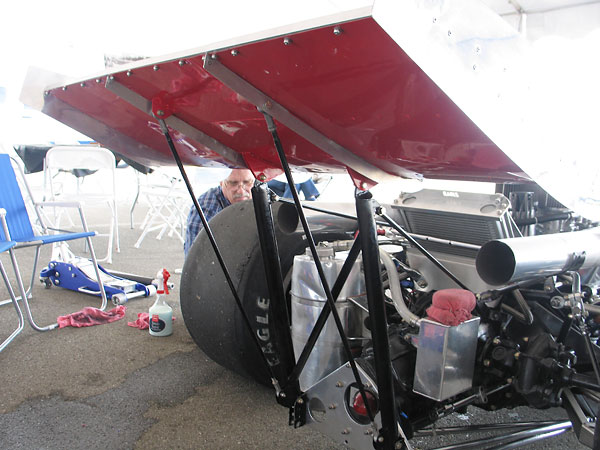
�
Throughout most of the 1970 season, the car raced with a very high-mounted rear wing.
�
Special Canadian rules required a lower mounted wing for the Edmonton race.
�
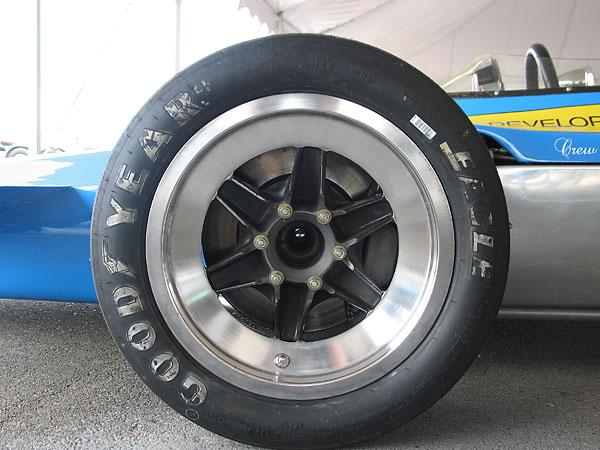
�
Original Lola cast magnesium wheels (15"x10.5" front, 15"x17" rear).
�

�
Goodyear Eagle Sportscar Special tires (23.0x10.5x15 front, 27.0x14.0x15 rear).
�

�
We enjoyed watching Eric's beautiful Lola T190 at the 2009 U.S. Vintage Grand Prix of Watkins Glen
�
It's best lap that weekend was 2:13.658, for an average of 91.6mph over the challenging 3.4 mile circuit.
�
| Notes: | |||||||
| (1) | �
The quote is from Mark Donohue's autobiography, The Unfair Advantage. In it, Donohue �
explains that he only drove the Lola T190 in that one race because of a special arrangement�
with the car's owner, Carl Haas. The car was then sold to one of Carl Haas's customers.�
For much of 1970, Donohue would be busy racing in other series. That's the year he placed �
second in the Indianapolis 500, driving a Lola-Ford, He also actively campaigned an AMC �
Javelin in the NASCAR stock car series.�
� Just in time production: according to Lola records Mark Donohue's T190 was shipped from their � factory in England on December 12th, and Jo Bonnier's T190 was shipped on December 15th. � Both cars were supplied without engines.� � | ||||||
| (2) | �
We're completely certain the torsional rigidity figure quoted on the original specifications �
sheet from Charlie Hayes Racing Equipment is erroneous. As a practical matter, torsional�
rigidity is normally measured over a car's wheelbase. The appropriate unit of measure �
is "foot-pounds per degree". Mark Donohue recounted in The Unfair Advantage how �
the Penske race team checked the torsional rigidity of a Lola T330 chassis (circa 1973):�
� "I was hoping that the basic problem was too much flex in the chassis. When the next� car arrived we set it up on our surface plate, replaced the springs with solid bars,� and tested its torsional rigidity. Woody spent a week at it, anchoring one end, twisting� the other end with hydraulic jacks, and measuring the deflection with dial gauges. It� turned out to have a stiffness of about 4000 foot-pounds per degree, which ought to � be perfectly adequate for a race car. We could see a little bending in the middle,� though, so we added a couple of extra braces between the roll bar and cylinder heads." � � Bob Marston, Eric Broadley's Chief Engineer through most of the Formula 5000 era, � has informed us that Lola practice was slightly different. Lola measured chassis � stiffness by connecting directly to the chassis at the front and rear shock absorber � mounting points. A measurement of 4000 foot-pounds per degree is within the right� order of magnitude, although he would expect the T330 to be significantly stiffer� than the T190 because the T330 was a more sophisticated design. � � | ||||||
| (3) | �
Various wheelbase measurements have been published for the Lola T190. Although original �
sales literature (above) from Charlie Hayes Racing Equipment cited a wheelbase of 92", �
in the course of researching Mead Korwin's Lola T192 we have been in touch with former �
Lola Chief Engineer Bob Marston. Bob visited with Lola historian Glyn Jones, and �
reported back as follows: "When we checked the original T190 layouts, the wheelbase was �
definitely 88 inches and not any of the many other dimensions that I have seen quoted."�
� | ||||||
�
All photos shown here, except one, are from September 2009 when we viewed the car at The US Vintage Grand �
Prix at Watkins Glen. Photos by Curtis Jacobson and Don Moyer for BritishRaceCar.com, copyright 2010. �
All rights reserved. The one exception is the close-up photo of the Weaver Brothers oil pump, which �
was taken by Eric Haga and which is used by exclusive permission.
�
| If you liked this article, you'll probably also enjoy these: | �|||||
 | �
Bill Thumel '67 Lola T70 Mk3 | �
 | �
Mead Korwin '71 Lola T192 | �
 | �
Jim Stengel '73 McRae GM-1 | �
| You're invited to discuss anything you've seen here on The British Racecar Motorsports Forum! | �|||||
�
Notice: all the articles and almost all the photos on BritishRacecar.com are by Curtis Jacobson.
�
(Photos that aren't by Curtis are explicitly credited.) Reproduction without prior written permission is prohibited.
�
Contact us to purchase images or reproduction permission. Higher resolution images are optionally available.
�

 �
�